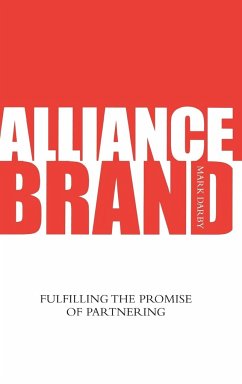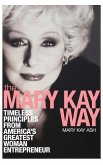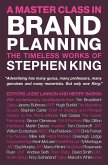Mark Darby
Alliance Brand
Mark Darby
Alliance Brand
- Gebundenes Buch
- Merkliste
- Auf die Merkliste
- Bewerten Bewerten
- Teilen
- Produkt teilen
- Produkterinnerung
- Produkterinnerung
Pressure continues to grow on organizations to achieve more with fewer resources. M&A s often fail to deliver value, so businesses are looking to partnering as a strategic solution, In this book, alliance authority Mark Darby argues that the perceived brand of a potential alliance partner is a key criterion for success.
As pressure continues to build on organisations to achieve more with less, partnering offers tremendous promise as a strategic solution. However, up to 70% of such initiatives fail to meet their objectives. In this book, alliance expert Mark Darby argues that, in the age of…mehr
Andere Kunden interessierten sich auch für
![Mary Kay Way Mary Kay Way]() Mary K. AshMary Kay Way33,99 €
Mary K. AshMary Kay Way33,99 €![A Master Class in Brand Planning A Master Class in Brand Planning]() Judie Lannon / Merry Baskin (eds.)A Master Class in Brand Planning69,99 €
Judie Lannon / Merry Baskin (eds.)A Master Class in Brand Planning69,99 €![Brand Vision Brand Vision]() David TaylorBrand Vision46,99 €
David TaylorBrand Vision46,99 €![If You're Not First, You're Last If You're Not First, You're Last]() Grant CardoneIf You're Not First, You're Last29,99 €
Grant CardoneIf You're Not First, You're Last29,99 €![The Irresistible Offer The Irresistible Offer]() Mark JoynerThe Irresistible Offer30,99 €
Mark JoynerThe Irresistible Offer30,99 €![Ten Deadly Marketing Sins Ten Deadly Marketing Sins]() Philip KotlerTen Deadly Marketing Sins30,99 €
Philip KotlerTen Deadly Marketing Sins30,99 €![Brand Manners Brand Manners]() Hamish PringleBrand Manners22,99 €
Hamish PringleBrand Manners22,99 €-
-
-
Pressure continues to grow on organizations to achieve more with fewer resources. M&A s often fail to deliver value, so businesses are looking to partnering as a strategic solution, In this book, alliance authority Mark Darby argues that the perceived brand of a potential alliance partner is a key criterion for success.
As pressure continues to build on organisations to achieve more with less, partnering offers tremendous promise as a strategic solution. However, up to 70% of such initiatives fail to meet their objectives. In this book, alliance expert Mark Darby argues that, in the age of the extended enterprise, firms must display a positive reputation and hard results from their alliances in order to attract the best partners and stand out from the growing crowd of potential allies. Building on this, he introduces the Alliance Brand concept, explores its critical success factors, and shows in detail how to apply it in your organisation.
Darby's straightforward advice and comprehensive maps and tools will guide you on the journey to fulfilling the promise of partnering. The results are higher revenues and reduced alliance failure rates, along with lower costs and fewer risks. Alliance brands also have more satisfied staff and partners, and a transparent, audit-friendly process to satisfy increasing governance concerns. This leads to sustainable alliance success, and ultimately 'partner of choice' status in your chosen industries and markets.
That's a compelling return on investment. That's an Alliance Brand.
Hinweis: Dieser Artikel kann nur an eine deutsche Lieferadresse ausgeliefert werden.
As pressure continues to build on organisations to achieve more with less, partnering offers tremendous promise as a strategic solution. However, up to 70% of such initiatives fail to meet their objectives. In this book, alliance expert Mark Darby argues that, in the age of the extended enterprise, firms must display a positive reputation and hard results from their alliances in order to attract the best partners and stand out from the growing crowd of potential allies. Building on this, he introduces the Alliance Brand concept, explores its critical success factors, and shows in detail how to apply it in your organisation.
Darby's straightforward advice and comprehensive maps and tools will guide you on the journey to fulfilling the promise of partnering. The results are higher revenues and reduced alliance failure rates, along with lower costs and fewer risks. Alliance brands also have more satisfied staff and partners, and a transparent, audit-friendly process to satisfy increasing governance concerns. This leads to sustainable alliance success, and ultimately 'partner of choice' status in your chosen industries and markets.
That's a compelling return on investment. That's an Alliance Brand.
Hinweis: Dieser Artikel kann nur an eine deutsche Lieferadresse ausgeliefert werden.
Produktdetails
- Produktdetails
- Verlag: Wiley & Sons
- 1. Auflage
- Seitenzahl: 408
- Erscheinungstermin: 1. September 2006
- Englisch
- Abmessung: 235mm x 157mm x 29mm
- Gewicht: 954g
- ISBN-13: 9780470032183
- ISBN-10: 0470032189
- Artikelnr.: 20894683
- Herstellerkennzeichnung
- Libri GmbH
- Europaallee 1
- 36244 Bad Hersfeld
- gpsr@libri.de
- Verlag: Wiley & Sons
- 1. Auflage
- Seitenzahl: 408
- Erscheinungstermin: 1. September 2006
- Englisch
- Abmessung: 235mm x 157mm x 29mm
- Gewicht: 954g
- ISBN-13: 9780470032183
- ISBN-10: 0470032189
- Artikelnr.: 20894683
- Herstellerkennzeichnung
- Libri GmbH
- Europaallee 1
- 36244 Bad Hersfeld
- gpsr@libri.de
Mark Darby is Founder & Principal of ALLIANTIST. ALLIANTIST is an alliance solutions provider that enables organisations to get measurable benefits from their partnering and alliance activity. ALLIANTIST helps clients generate a positive reputation and results from their alliance activity, creating real value from the way they work with internal colleagues, alliance partners, suppliers, distributors, customers, and even competitors. Prior to ALLIANTIST Mark led the UK extended enterprise consulting activity for Deloitte, and before that designed and built Reuters first UK and then global alliance programme. He was also instrumental at The Rank Group over eight years with its alliances, strategic sourcing and supplier relationship management activity. Having operated for nearly twenty years across the value chain as advisor, supplier, customer and partner in working with global and international organisations like HP, Deloitte, Reuters, Cisco, IBM, Siebel, Fujitsu, The Rank Group, BT, the UK Public Sector and many small and medium size enterprises, Mark is well placed to share his experience and make a real difference quickly. Mark also has an MBA from the University of Reading where he carried out extensive research on alliances. He is a Member of the Institute of Directors, a Fellow of the Chartered Institute of Management, a Member of the Chartered Institute of Marketing, a Member of the Chartered Institute of Purchasing & Supply as well as a Member of Association of Strategic Alliance Professionals (ASAP) and ex Board Director of the European branch of ASAP. Mark is also a regular speaker on alliances and has been published in a number of business journals.
FOREWORD BY JEFF ALEXANDER, SEEDA xiii
ACKNOWLEDGEMENTS xv
PREFACE xix
PART I USING ALLIANCES TO CREATE VALUE 1
1 HOW VALUE AND ADVANTAGE AFFECT FIRM ACTIVITIES 3
What is value 3
Understanding competitive advantage 6
2 UNDERSTANDING ALLIANCES 13
Alliance ambiguity 13
Defining alliances 14
What alliances are not 16
Assets are what you access 17
Alliances pervade the value chain 18
Alliances have differing values and importance 21
Partners come from various sources 24
Complex relationships 26
3 FORCES DRIVING FOR ALLIANCES 29
Customer demands and industry standards 30
Increasing pace of change with growth and cost pressures 31
Regulation and governance 33
Increasing M&A challenges 35
Capital, size, learning and competitive threat 36
4 WHAT WINNING ALLIANCES LOOK LIKE 39
Alliance spirit 39
Building trust 40
What an organisation that wins with alliances does for success 47
5 FORCES CHALLENGING ALLIANCE SUCCESS 53
Alliance failure rates 53
Other forces challenging success 60
6 ALLIANCE BRAND 67
Reputation in context 67
Brand in context 70
Alliance brand; a timely initiative 72
Examples of alliance brands 76
Getting results, reputation and alliance brand status 80
Does your organisation need an alliance brand? 82
PART I SUMMARY 85
PART II HAVING A CAPABILITY TO PARTNER 87
7 CLARITY ON STRATEGY AND DIRECTION 91
The importance of clarity on strategy and direction 92
Pitfalls to avoid 96
Achieving clarity on strategy and direction 98
How to ensure the strategy and direction create value 100
8 CLARITY ON CORE COMPETENCES 105
The importance of clarity on core competences 106
Defining core competences 107
Effective internal analysis 110
The challenges of internal analysis 121
What happens next 122
9 ABILITY TO MAKE EFFECTIVE STRATEGIC CHOICES 125
Alliances are only one option 125
Strengths and weaknesses of other options 126
Bringing it together in a coherent framework 129
10 ATTRACTIVENESS OF ASSETS 135
Using assets effectively 135
Leveraging assets 140
Identifying assets 140
Assessing values 142
Conducting asset risk assessments 144
Setting the framework for use and monitoring its effectiveness 146
11 ABILITY TO COLLABORATE INTERNALLY AND EXTERNALLY 149
Collaborative cultures 149
Factors affecting collaboration 152
12 ABILITY TO GOVERN EFFECTIVELY AND MANAGE COMPLEX RELATIONSHIPS 177
View increasing legislation as opportunity not threat 178
Dealing effectively with complex relationships 183
Managing reciprocity 191
13 EFFECTIVENESS OF ALLIANCE INFRASTRUCTURE 193
Ability to segment, measure and manage overall portfolio performance 194
Programme fit and importance within the firm 204
Resources focused on alliance activity 208
Ease of doing and not doing business with other parties 223
Proposition attractiveness 227
Ability to select the right partners and relationships 232
Ability to deliver on alliance commitments 234
Ability to develop, protect and share knowledge 239
PART II SUMMARY 243
PART III WINNING WITH ALLIANCES 245
14 PHASE 1: PRE-ALLIANCE 249
Context 249
Phase 1 aims 250
Output A: forces pushing for the alliance 250
Output B: alliance as the right choice 252
Output C: headline benefits 253
Output D: headline risks 253
Output E: sponsor identified and stakeholders on board 254
Output F: support resources and costs 257
Progress to Phase 2 257
Pitfalls to avoid 258
Summary of tools needed for Phase 1 258
15 PHASE 2: PRE-PARTNER 261
Context 261
Phase 2 aims 262
Output A: alliance team alignment 262
Output B: attractive value proposition for the participants 266
Output C: organisation readiness 275
Output D: ideal partner characteristics 278
Output E: engagement plan and partner selection 283
Output F: stakeholder and risk management 288
Progress to Phase 3 288
Pitfalls to avoid 288
Summary of tools needed for Phase 2 290
16 PHASE 3: WITH-PARTNER PLANNING 293
Context 293
Phase 3 aims 294
Output A: compelling value proposition and targets aligned 294
Output B: complete mutual due diligence 299
Output C: effective relationship architecture designed 300
Progress to Phase 4 314
Pitfalls to avoid 314
Summary of tools needed for Phase 3 316
17 PHASE 4: ALLIANCE LAUNCH 317
Context 317
Phase 4 aims 318
Output A: project and change management 319
Output B: announcing the alliance 321
Progress to Phase 5 322
Pitfalls to avoid 322
Summary of tools needed for Phase 4 323
18 PHASE 5: WITH-PARTNER DELIVERY 325
Context 325
Phase 5 aims 326
Outputs A and B: results and relationships 326
Progress to Phase 6 332
Pitfalls to avoid 332
Summary of tools needed for Phase 5 333
19 PHASE 6: ALLIANCE REVIEWS 335
Context 335
Phase 6 aims 336
Output A: objective assessment 336
Output B: actions and next steps 341
Progress 342
Pitfalls to avoid 343
Summary of tools needed for Phase 6 343
20 THE JOURNEY TO ALLIANCE BRAND AND WINNING ALLIANCES 345
Getting started 346
Standing out from the crowd 349
ALLIANTIST services 350
Concluding remarks 351
APPENDIX ALLIANCE BRAND QUICK TEST 353
REFERENCES 357
INDEX 363
ACKNOWLEDGEMENTS xv
PREFACE xix
PART I USING ALLIANCES TO CREATE VALUE 1
1 HOW VALUE AND ADVANTAGE AFFECT FIRM ACTIVITIES 3
What is value 3
Understanding competitive advantage 6
2 UNDERSTANDING ALLIANCES 13
Alliance ambiguity 13
Defining alliances 14
What alliances are not 16
Assets are what you access 17
Alliances pervade the value chain 18
Alliances have differing values and importance 21
Partners come from various sources 24
Complex relationships 26
3 FORCES DRIVING FOR ALLIANCES 29
Customer demands and industry standards 30
Increasing pace of change with growth and cost pressures 31
Regulation and governance 33
Increasing M&A challenges 35
Capital, size, learning and competitive threat 36
4 WHAT WINNING ALLIANCES LOOK LIKE 39
Alliance spirit 39
Building trust 40
What an organisation that wins with alliances does for success 47
5 FORCES CHALLENGING ALLIANCE SUCCESS 53
Alliance failure rates 53
Other forces challenging success 60
6 ALLIANCE BRAND 67
Reputation in context 67
Brand in context 70
Alliance brand; a timely initiative 72
Examples of alliance brands 76
Getting results, reputation and alliance brand status 80
Does your organisation need an alliance brand? 82
PART I SUMMARY 85
PART II HAVING A CAPABILITY TO PARTNER 87
7 CLARITY ON STRATEGY AND DIRECTION 91
The importance of clarity on strategy and direction 92
Pitfalls to avoid 96
Achieving clarity on strategy and direction 98
How to ensure the strategy and direction create value 100
8 CLARITY ON CORE COMPETENCES 105
The importance of clarity on core competences 106
Defining core competences 107
Effective internal analysis 110
The challenges of internal analysis 121
What happens next 122
9 ABILITY TO MAKE EFFECTIVE STRATEGIC CHOICES 125
Alliances are only one option 125
Strengths and weaknesses of other options 126
Bringing it together in a coherent framework 129
10 ATTRACTIVENESS OF ASSETS 135
Using assets effectively 135
Leveraging assets 140
Identifying assets 140
Assessing values 142
Conducting asset risk assessments 144
Setting the framework for use and monitoring its effectiveness 146
11 ABILITY TO COLLABORATE INTERNALLY AND EXTERNALLY 149
Collaborative cultures 149
Factors affecting collaboration 152
12 ABILITY TO GOVERN EFFECTIVELY AND MANAGE COMPLEX RELATIONSHIPS 177
View increasing legislation as opportunity not threat 178
Dealing effectively with complex relationships 183
Managing reciprocity 191
13 EFFECTIVENESS OF ALLIANCE INFRASTRUCTURE 193
Ability to segment, measure and manage overall portfolio performance 194
Programme fit and importance within the firm 204
Resources focused on alliance activity 208
Ease of doing and not doing business with other parties 223
Proposition attractiveness 227
Ability to select the right partners and relationships 232
Ability to deliver on alliance commitments 234
Ability to develop, protect and share knowledge 239
PART II SUMMARY 243
PART III WINNING WITH ALLIANCES 245
14 PHASE 1: PRE-ALLIANCE 249
Context 249
Phase 1 aims 250
Output A: forces pushing for the alliance 250
Output B: alliance as the right choice 252
Output C: headline benefits 253
Output D: headline risks 253
Output E: sponsor identified and stakeholders on board 254
Output F: support resources and costs 257
Progress to Phase 2 257
Pitfalls to avoid 258
Summary of tools needed for Phase 1 258
15 PHASE 2: PRE-PARTNER 261
Context 261
Phase 2 aims 262
Output A: alliance team alignment 262
Output B: attractive value proposition for the participants 266
Output C: organisation readiness 275
Output D: ideal partner characteristics 278
Output E: engagement plan and partner selection 283
Output F: stakeholder and risk management 288
Progress to Phase 3 288
Pitfalls to avoid 288
Summary of tools needed for Phase 2 290
16 PHASE 3: WITH-PARTNER PLANNING 293
Context 293
Phase 3 aims 294
Output A: compelling value proposition and targets aligned 294
Output B: complete mutual due diligence 299
Output C: effective relationship architecture designed 300
Progress to Phase 4 314
Pitfalls to avoid 314
Summary of tools needed for Phase 3 316
17 PHASE 4: ALLIANCE LAUNCH 317
Context 317
Phase 4 aims 318
Output A: project and change management 319
Output B: announcing the alliance 321
Progress to Phase 5 322
Pitfalls to avoid 322
Summary of tools needed for Phase 4 323
18 PHASE 5: WITH-PARTNER DELIVERY 325
Context 325
Phase 5 aims 326
Outputs A and B: results and relationships 326
Progress to Phase 6 332
Pitfalls to avoid 332
Summary of tools needed for Phase 5 333
19 PHASE 6: ALLIANCE REVIEWS 335
Context 335
Phase 6 aims 336
Output A: objective assessment 336
Output B: actions and next steps 341
Progress 342
Pitfalls to avoid 343
Summary of tools needed for Phase 6 343
20 THE JOURNEY TO ALLIANCE BRAND AND WINNING ALLIANCES 345
Getting started 346
Standing out from the crowd 349
ALLIANTIST services 350
Concluding remarks 351
APPENDIX ALLIANCE BRAND QUICK TEST 353
REFERENCES 357
INDEX 363
FOREWORD BY JEFF ALEXANDER, SEEDA xiii
ACKNOWLEDGEMENTS xv
PREFACE xix
PART I USING ALLIANCES TO CREATE VALUE 1
1 HOW VALUE AND ADVANTAGE AFFECT FIRM ACTIVITIES 3
What is value 3
Understanding competitive advantage 6
2 UNDERSTANDING ALLIANCES 13
Alliance ambiguity 13
Defining alliances 14
What alliances are not 16
Assets are what you access 17
Alliances pervade the value chain 18
Alliances have differing values and importance 21
Partners come from various sources 24
Complex relationships 26
3 FORCES DRIVING FOR ALLIANCES 29
Customer demands and industry standards 30
Increasing pace of change with growth and cost pressures 31
Regulation and governance 33
Increasing M&A challenges 35
Capital, size, learning and competitive threat 36
4 WHAT WINNING ALLIANCES LOOK LIKE 39
Alliance spirit 39
Building trust 40
What an organisation that wins with alliances does for success 47
5 FORCES CHALLENGING ALLIANCE SUCCESS 53
Alliance failure rates 53
Other forces challenging success 60
6 ALLIANCE BRAND 67
Reputation in context 67
Brand in context 70
Alliance brand; a timely initiative 72
Examples of alliance brands 76
Getting results, reputation and alliance brand status 80
Does your organisation need an alliance brand? 82
PART I SUMMARY 85
PART II HAVING A CAPABILITY TO PARTNER 87
7 CLARITY ON STRATEGY AND DIRECTION 91
The importance of clarity on strategy and direction 92
Pitfalls to avoid 96
Achieving clarity on strategy and direction 98
How to ensure the strategy and direction create value 100
8 CLARITY ON CORE COMPETENCES 105
The importance of clarity on core competences 106
Defining core competences 107
Effective internal analysis 110
The challenges of internal analysis 121
What happens next 122
9 ABILITY TO MAKE EFFECTIVE STRATEGIC CHOICES 125
Alliances are only one option 125
Strengths and weaknesses of other options 126
Bringing it together in a coherent framework 129
10 ATTRACTIVENESS OF ASSETS 135
Using assets effectively 135
Leveraging assets 140
Identifying assets 140
Assessing values 142
Conducting asset risk assessments 144
Setting the framework for use and monitoring its effectiveness 146
11 ABILITY TO COLLABORATE INTERNALLY AND EXTERNALLY 149
Collaborative cultures 149
Factors affecting collaboration 152
12 ABILITY TO GOVERN EFFECTIVELY AND MANAGE COMPLEX RELATIONSHIPS 177
View increasing legislation as opportunity not threat 178
Dealing effectively with complex relationships 183
Managing reciprocity 191
13 EFFECTIVENESS OF ALLIANCE INFRASTRUCTURE 193
Ability to segment, measure and manage overall portfolio performance 194
Programme fit and importance within the firm 204
Resources focused on alliance activity 208
Ease of doing and not doing business with other parties 223
Proposition attractiveness 227
Ability to select the right partners and relationships 232
Ability to deliver on alliance commitments 234
Ability to develop, protect and share knowledge 239
PART II SUMMARY 243
PART III WINNING WITH ALLIANCES 245
14 PHASE 1: PRE-ALLIANCE 249
Context 249
Phase 1 aims 250
Output A: forces pushing for the alliance 250
Output B: alliance as the right choice 252
Output C: headline benefits 253
Output D: headline risks 253
Output E: sponsor identified and stakeholders on board 254
Output F: support resources and costs 257
Progress to Phase 2 257
Pitfalls to avoid 258
Summary of tools needed for Phase 1 258
15 PHASE 2: PRE-PARTNER 261
Context 261
Phase 2 aims 262
Output A: alliance team alignment 262
Output B: attractive value proposition for the participants 266
Output C: organisation readiness 275
Output D: ideal partner characteristics 278
Output E: engagement plan and partner selection 283
Output F: stakeholder and risk management 288
Progress to Phase 3 288
Pitfalls to avoid 288
Summary of tools needed for Phase 2 290
16 PHASE 3: WITH-PARTNER PLANNING 293
Context 293
Phase 3 aims 294
Output A: compelling value proposition and targets aligned 294
Output B: complete mutual due diligence 299
Output C: effective relationship architecture designed 300
Progress to Phase 4 314
Pitfalls to avoid 314
Summary of tools needed for Phase 3 316
17 PHASE 4: ALLIANCE LAUNCH 317
Context 317
Phase 4 aims 318
Output A: project and change management 319
Output B: announcing the alliance 321
Progress to Phase 5 322
Pitfalls to avoid 322
Summary of tools needed for Phase 4 323
18 PHASE 5: WITH-PARTNER DELIVERY 325
Context 325
Phase 5 aims 326
Outputs A and B: results and relationships 326
Progress to Phase 6 332
Pitfalls to avoid 332
Summary of tools needed for Phase 5 333
19 PHASE 6: ALLIANCE REVIEWS 335
Context 335
Phase 6 aims 336
Output A: objective assessment 336
Output B: actions and next steps 341
Progress 342
Pitfalls to avoid 343
Summary of tools needed for Phase 6 343
20 THE JOURNEY TO ALLIANCE BRAND AND WINNING ALLIANCES 345
Getting started 346
Standing out from the crowd 349
ALLIANTIST services 350
Concluding remarks 351
APPENDIX ALLIANCE BRAND QUICK TEST 353
REFERENCES 357
INDEX 363
ACKNOWLEDGEMENTS xv
PREFACE xix
PART I USING ALLIANCES TO CREATE VALUE 1
1 HOW VALUE AND ADVANTAGE AFFECT FIRM ACTIVITIES 3
What is value 3
Understanding competitive advantage 6
2 UNDERSTANDING ALLIANCES 13
Alliance ambiguity 13
Defining alliances 14
What alliances are not 16
Assets are what you access 17
Alliances pervade the value chain 18
Alliances have differing values and importance 21
Partners come from various sources 24
Complex relationships 26
3 FORCES DRIVING FOR ALLIANCES 29
Customer demands and industry standards 30
Increasing pace of change with growth and cost pressures 31
Regulation and governance 33
Increasing M&A challenges 35
Capital, size, learning and competitive threat 36
4 WHAT WINNING ALLIANCES LOOK LIKE 39
Alliance spirit 39
Building trust 40
What an organisation that wins with alliances does for success 47
5 FORCES CHALLENGING ALLIANCE SUCCESS 53
Alliance failure rates 53
Other forces challenging success 60
6 ALLIANCE BRAND 67
Reputation in context 67
Brand in context 70
Alliance brand; a timely initiative 72
Examples of alliance brands 76
Getting results, reputation and alliance brand status 80
Does your organisation need an alliance brand? 82
PART I SUMMARY 85
PART II HAVING A CAPABILITY TO PARTNER 87
7 CLARITY ON STRATEGY AND DIRECTION 91
The importance of clarity on strategy and direction 92
Pitfalls to avoid 96
Achieving clarity on strategy and direction 98
How to ensure the strategy and direction create value 100
8 CLARITY ON CORE COMPETENCES 105
The importance of clarity on core competences 106
Defining core competences 107
Effective internal analysis 110
The challenges of internal analysis 121
What happens next 122
9 ABILITY TO MAKE EFFECTIVE STRATEGIC CHOICES 125
Alliances are only one option 125
Strengths and weaknesses of other options 126
Bringing it together in a coherent framework 129
10 ATTRACTIVENESS OF ASSETS 135
Using assets effectively 135
Leveraging assets 140
Identifying assets 140
Assessing values 142
Conducting asset risk assessments 144
Setting the framework for use and monitoring its effectiveness 146
11 ABILITY TO COLLABORATE INTERNALLY AND EXTERNALLY 149
Collaborative cultures 149
Factors affecting collaboration 152
12 ABILITY TO GOVERN EFFECTIVELY AND MANAGE COMPLEX RELATIONSHIPS 177
View increasing legislation as opportunity not threat 178
Dealing effectively with complex relationships 183
Managing reciprocity 191
13 EFFECTIVENESS OF ALLIANCE INFRASTRUCTURE 193
Ability to segment, measure and manage overall portfolio performance 194
Programme fit and importance within the firm 204
Resources focused on alliance activity 208
Ease of doing and not doing business with other parties 223
Proposition attractiveness 227
Ability to select the right partners and relationships 232
Ability to deliver on alliance commitments 234
Ability to develop, protect and share knowledge 239
PART II SUMMARY 243
PART III WINNING WITH ALLIANCES 245
14 PHASE 1: PRE-ALLIANCE 249
Context 249
Phase 1 aims 250
Output A: forces pushing for the alliance 250
Output B: alliance as the right choice 252
Output C: headline benefits 253
Output D: headline risks 253
Output E: sponsor identified and stakeholders on board 254
Output F: support resources and costs 257
Progress to Phase 2 257
Pitfalls to avoid 258
Summary of tools needed for Phase 1 258
15 PHASE 2: PRE-PARTNER 261
Context 261
Phase 2 aims 262
Output A: alliance team alignment 262
Output B: attractive value proposition for the participants 266
Output C: organisation readiness 275
Output D: ideal partner characteristics 278
Output E: engagement plan and partner selection 283
Output F: stakeholder and risk management 288
Progress to Phase 3 288
Pitfalls to avoid 288
Summary of tools needed for Phase 2 290
16 PHASE 3: WITH-PARTNER PLANNING 293
Context 293
Phase 3 aims 294
Output A: compelling value proposition and targets aligned 294
Output B: complete mutual due diligence 299
Output C: effective relationship architecture designed 300
Progress to Phase 4 314
Pitfalls to avoid 314
Summary of tools needed for Phase 3 316
17 PHASE 4: ALLIANCE LAUNCH 317
Context 317
Phase 4 aims 318
Output A: project and change management 319
Output B: announcing the alliance 321
Progress to Phase 5 322
Pitfalls to avoid 322
Summary of tools needed for Phase 4 323
18 PHASE 5: WITH-PARTNER DELIVERY 325
Context 325
Phase 5 aims 326
Outputs A and B: results and relationships 326
Progress to Phase 6 332
Pitfalls to avoid 332
Summary of tools needed for Phase 5 333
19 PHASE 6: ALLIANCE REVIEWS 335
Context 335
Phase 6 aims 336
Output A: objective assessment 336
Output B: actions and next steps 341
Progress 342
Pitfalls to avoid 343
Summary of tools needed for Phase 6 343
20 THE JOURNEY TO ALLIANCE BRAND AND WINNING ALLIANCES 345
Getting started 346
Standing out from the crowd 349
ALLIANTIST services 350
Concluding remarks 351
APPENDIX ALLIANCE BRAND QUICK TEST 353
REFERENCES 357
INDEX 363








